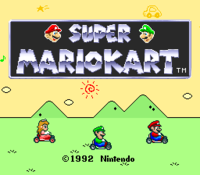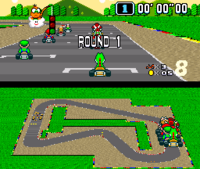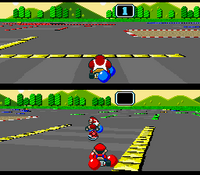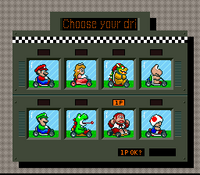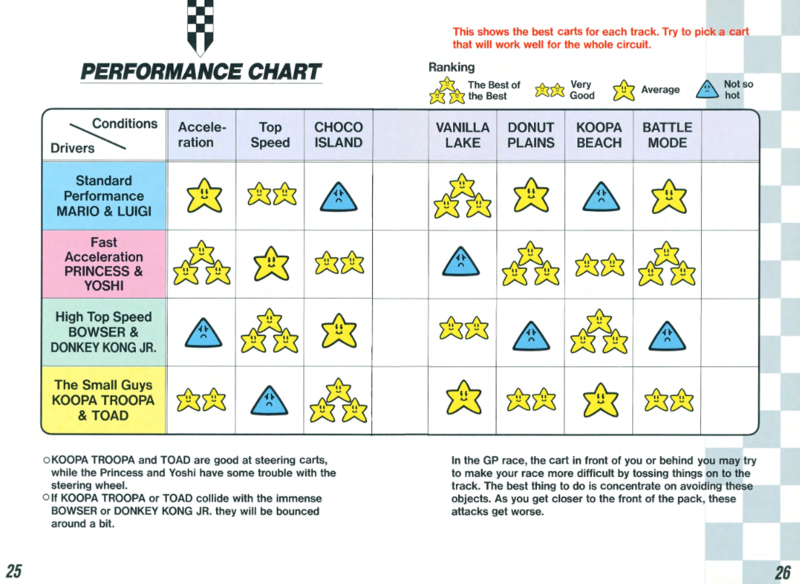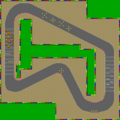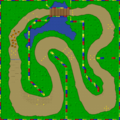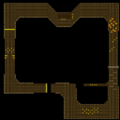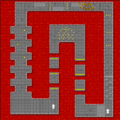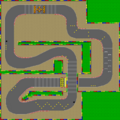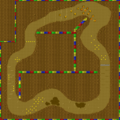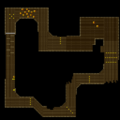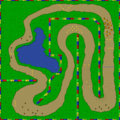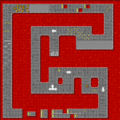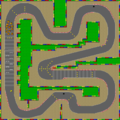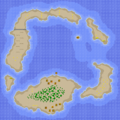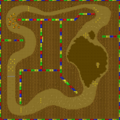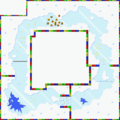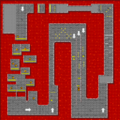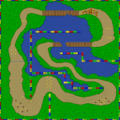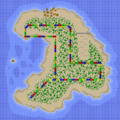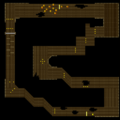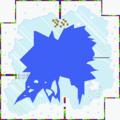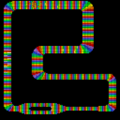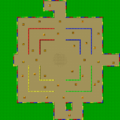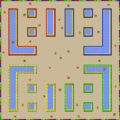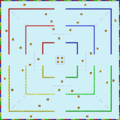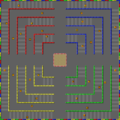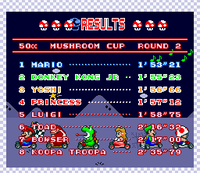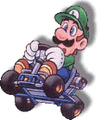Super Mario Kart
- This article is about the game for the Super Nintendo Entertainment System. For the microgame from WarioWare Gold of the same name, see Super Mario Kart (microgame).
- "SMK" redirects here. For information about Super Mario-Kun, see here.
Template:Infobox Super Mario Kart is a racing game for the Super Nintendo Entertainment System, which was first released in 1992 and re-released in 1996 as a Player's Choice title. Unlike other racing games at the time, which focused on single player pure racing with more complicated tracks, Super Mario Kart had a development focused on two players and was designed to be an easy and intuitive "pick up and play" experience that heavily involves the use of acquiring weapons on an obstacle course-like track to impede another player's progress. The development of a one-on-one Battle Mode was invented as another way to enjoy the competitive system by another means. A notable aspect of the game is its Mode 7 graphics, where the game simulates a 3D plane by rotating and scaling a background graphic on a scanline basis, allowing players to simulate driving through a track. Part of this game is heavily based on Super Mario World in terms of graphics and overall theme, such as sprites reusing assets from Super Mario World and the game's soundtrack rearranging Super Mario World melodies.
The game's high success has created the hugely influential Mario Kart series, as well as being the pioneer of the kart-racing genre. Due to the game's success and creation of the Mario Kart spin-off, many elements from the game has found their way into multiple other Mario series, such as Super Mario 3D World receiving a level designed after one of its courses. The game's use of its wider cast of characters such as Bowser and Peach has likely influenced the creation of later multiplayer-oriented Mario spin-off titles that involved a playable, larger cast of Mario characters such as Mario Tennis and Mario Party. It has ranked among the greatest games of all time by various organizations due to its legacy and its well-designed gameplay.
It was re-released on the Wii's Virtual Console in 2009-2010. Super Mario Kart was re-released again on the Wii U's Virtual Console in 2013-2014, and exclusively for the New Nintendo 3DS's Virtual Console in 2016, and is one of the 21 titles included on the Super NES Classic Edition and one of the 20 launch titles for Super Nintendo Entertainment System - Nintendo Switch Online.
Gameplay
Players pick a Mario character out of a cast of 8 characters to race against opponents; racers have their own stats which determine how they will control, though it is not displayed in-game. In a race, players must rank high in the opposition by completing a race around a racetrack first, which consists of five laps due to their short length. Integral to the gameplay is the item system, where players can pick up items from Question Blocks mostly clustered around parts of the track, where the item obtained is dependent on their position. For example, players further behind obtain stronger items such as the invincible, speed-raising Star or the Lightning that can shrink all racers while players in better positions receive the basic Banana Peels and Green Shells items. Question Blocks get depleted whenever a player runs over them, and they do not respawn their items until all Question Blocks in the track get used up.
At the start of the race, players can rev up for a boost, though if they rev up too much, they accelerate much slower. Players can hop if they press either and
. If they hold the button after hopping, they can power slide, which will enable them to drive through harder turns while losing less speed than steering through them. While karts in this game can brake with
, they cannot go in reverse: players need to hop around to go backwards. Some tracks feature water that players can fall into: if players fall into deeper areas, players can move around for a little while before eventually being picked up by Lakitu. Players immediately get rescued by Lakitu if they fall into pits or into lava, however.
In the course, coins are picked up, which increase the player's top speed as well as shield them from other racers: if a player runs into another racer while they have zero coins, they spin out. Having ten coins is the max speed a player can drive in, though players are able to collect extra coins. Players start out with a number of coins depending on their rank: first and second start with two coins, third and fourth start with three coins, fifth and sixth start with four coins, and seventh and eighth start with five coins. Players lose four coins if they are hit with an item, they lose two coins if they are picked up by Lakitu if they fall off the track, and they lose one coin if they bump into another racer.
Three speeds are available: 50cc, 100cc, and 150cc. 50cc is the slowest and therefore easiest difficulty while 150cc is the fastest and hardest engine class that much be unlocked by clearing all cups in the 100cc engine class. Vehicles in all modes outside of Mario Kart GP use 100cc engines.
The game is always split in two screens. The top screen is the main screen that players see the gameplay in while the bottom screen displays an overhead map, displaying progress of all characters. If players press or
, they can switch the overhead map to a backwards view. When two players are playing, the bottom map is replaced by the second player's screen.
If players want to delete their save data, they need to press ,
,
, and
at the title screen. If players want to delete just Time Trial records, they can go to the course records they wish to delete and press the same button combination.
Controls
| Action(s) | |||||
|---|---|---|---|---|---|
| SNES | Wii (Classic Controller) | New Nintendo 3DS | Wii U | Nintendo Switch | |
| Change option during the Menus/Steer | / | ||||
| Use items, stop Item Roulette | |||||
| Accelerate | |||||
| Switch view | / | ||||
| Brake | |||||
| Jump / Drift | / | ||||
| Pause / Select |
Game modes
Mario Kart GP
The Mario Kart GP is the main mode in Super Mario Kart. Here, up to two players can race against seven other CPU-controlled opponents in a five-course cup; they first start out in eighth place and must make their way to the top position; players keep their position for the next race if they end in that position. The top four players receive points based on their ranking: first place earns the player nine points, second earns six, third earns three, and fourth earns one, while fifth and below get zero points. Players who rank fifth or below lose one of three lives. If both players rank fifth or below, the race must be tried again. If the player ranks fifth or below without any lives left, the game ends. A single extra life can be earned by placing in the same position three times. The maximum score in a GP cup is forty-five, obtained by winning five times. The three best drivers move on to the award ceremony where they receive their trophies. Third place gives the player a bronze trophy, second gives silver, and first gives gold (the player can watch the ceremony only when they place first: however, a protoype version has animations for second and third). Each race is five laps long.
If players beat all of the cups in the 100cc engine class, the message "Excellent driving, you are now a Super Mario Kart expert" pops up, thus officially telling players that they have completed all four of the cups. If the player wants a harder challenge, they can now replay through the game in the 150cc engine class. If players beat all of the cups in the 150cc engine class, the same message as before pops up. If the player wants a more difficult challenge, they can hold and
at the character selection screen. This makes the character permanently small as if under the effect of a Lightning or Poison Mushroom until the player presses the buttons again.
Time Trial
This one-player mode have the player to race through five laps of the selected track the fastest they can without items or coins in the 100cc engine class. The five lap times are recorded which are then combined to make the total time, as well as the fastest lap time and the characters used, for each track.
In all the versions of Super Mario Kart except the Japanese version, if the player enters the cheat code L, R, L, R, L, L, R, R, A on the cup selection menu in Time Trial, the Special Cup is unlocked. In the Japanese version, a "Boo" sound is heard instead.[1]
Match Race
This mode is two-player only: the players can race each other like in GP, except CPU racers do not appear and players can freely choose the track to race in. Bullet Bills slide around the courses as well, and coming in contact with one will result in the kart spinning out and the object disappearing as if it were a Green Shell. The game keeps track of wins and losses of each player.
Battle Mode
- Main article: Battle Mode
A two-player exclusive mode where players combat each other with items in an arena. The goal is to eliminate the opposing player's balloons, which are represented by colored spheres rotating around the character. Each player has three balloons that cannot be recovered. The first to pop all the opponent's balloons wins.
Characters
The game features eight playable characters from the Mario franchise, such as Mario, Luigi, Yoshi, and Bowser. However, some other characters from the series acts as obstacles in the game's tracks, like Thwomps, Gophers, Piranha Plants, and Flopping Cheep Cheeps. Ghosts do not act as enemies, but both as item and as part of the Ghost Valley tracks' background.
As stated in the game's manual, Lakitu is the owner of all the racetracks, thus overseeing all races. It will appear on the track to start the race, to warn the player if they are going the wrong way on the course, and when they fall off the edge of the track or go out of bounds. If the latter happens, Lakitu will transport the racer back onto the course at the price of two Coins. A Cheep Cheep balloon distributes the trophy to the GP winner.
Drivers
Super Mario Kart has eight available drivers, divided into statistically identical pairs of two. While subsequent Mario Kart games would classify characters based on weight class, in this game other criteria are used. The stats presented here are derived and inferred from the manual.[2] The Bros are average drivers with a high top speed, The Dragon and The Lady have the highest acceleration with low handling, The Showdown have low acceleration and handling with the highest top speed and weight, while The Small Guys have high acceleration and handling, which makes them recommended for beginners. Each pair of characters has different engine sounds for their karts, which reflect their appearances and characteristics.
On a side note, this is only one of two Mario Kart games to feature Donkey Kong Jr. as a playable character (subsequent installments have replaced him with Donkey Kong), the other being Mario Kart Tour.
|
|
|
|
Maximum speed
The Japanese Official Nintendo Guidebook of the game lists the maximum speed in the 100cc engine class in various conditions.[3] This maximum speed is increased by 1 km/h per each coin collected, until 10 coins are collected.[4]
| Maximum speed in the 100cc engine class | |||||||
|---|---|---|---|---|---|---|---|
| Driver | Maximum speed (km/h) | ||||||
| Normal road | Circuits' sand | Choco Island's rocks | Choco Island's mud | Donut Plain's grass | Koopa Beach's water | Vanilla Lake's snow | |
| Mario Luigi |
130 | 84 | 40 | 90 | 82 | 82 | 76 |
| Princess Yoshi |
125 | 88 | 44 | 94 | 86 | 86 | 70 |
| Bowser Donkey Kong Jr. |
135 | 86 | 42 | 92 | 80 | 88 | 74 |
| Koopa Troopa Toad |
120 | 90 | 46 | 96 | 84 | 88 | 72 |
Acceleration
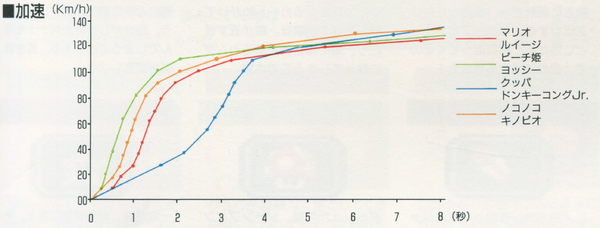
Performance chart
The official instruction manual illustrates a chart that details how well characters perform on tracks and their stats. It notes that Toad and Koopa Troopa have the best steering while the Princess and Yoshi steer worse. Another point it mentions is that Toad and Koopa Troopa can get knocked aside by Bowser and Donkey Kong Jr.
Non-Playable
| Characters and elements | ||
|---|---|---|
| Character/element | Location | Description |
Bullet Bill |
N/A | Appears in Match Races where they bounce back and forth between two walls and causes racers who drive into them to spin out. |
Flopping Cheep Cheep |
Koopa Beach | Out-of-water fish that spins players out if they come in contact with them. |
Ghosts |
Ghost Valley, appears as an item | Background elements in the Ghost Valley courses. They also appear as an item in Match Race and Battle Mode. |
Gopher |
Donut Plains | Gophers attach themselves onto racers if ran into, which cause them to lose speed and coins. Players must hop repeatedly to get them off. |
Lakitu |
N/A | A helpful track manager who oversees the race. He starts the race up, pulls racers out of lava, water, and pits, tells players that they are going the wrong way, and waves a checkered flag for a racer who has finished. |
Piranha Plant |
Choco Island | A carnivorous plant that acts like a stationary obstacle. Players who run into them spin out. |
Thwomp |
Bowser Castle, Rainbow Road | A hovering rock that stays stationary in the first lap of a course. In subsequent laps, they slam onto the floor in a pattern, and any racer caught in them get flattened. Flashing variants of Thwomps appear in Rainbow Road and act identically to Thwomps, though touching them causes racers to spin out, unlike regular Thwomps. |
Courses
The game has 20 race courses and 4 battle courses, the former being divided in four cups.
Race courses
Aside from Rainbow Road, all of the courses are numbered. In the credits, each character is assigned a course.
Some common hazards include the following:
- Water: Racers who fall in have a few seconds to drive out, before Lakitu picks them up. Koopa Beach contains shallow water that is safe to drive through. In Vanilla Lake, racers appear frozen when they are fished out.
- Lava: Racers who fall in immediately get picked up by Lakitu.
- Abyss: Racers who fall immediately get picked up by Lakitu.
- Destructible blocks: Walls that get destroyed when struck in Ghost Valley and Vanilla Lake.
- Dirt: Decreases traction when driven on in Donut Plains.
- Chocolate Mud: Decreases traction and slows speed when driven on in Choco Island.
| Name | Terrain and obstacles | |
|---|---|---|
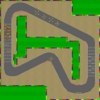
|
Mario Circuit | |
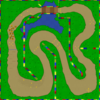
|
Donut Plains | |
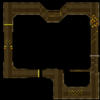
|
Ghost Valley |
|

|
Bowser Castle | |
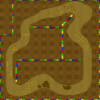
|
Choco Island |
|
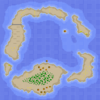
|
Koopa Beach |
|
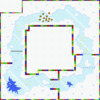
|
Vanilla Lake |
|
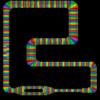
|
Rainbow Road |
|
Course features and obstacles
| Feature | Description |
|---|---|
 Coin |
These are scattered throughout the course and increase the player's speed as well as give them durability against opponents. They do not respawn once taken. |
Jump |
Players hop if they drive over this. Driving over it at high speeds causes racers to jump higher and further. |
Oil Slick |
Located in the Mario Circuits, players spin out if they drive over them. |
| File:SMK Warp Pipes.png Pipe |
Stationary obstacles found in Mario Circuit, Vanilla Lake, and Donut Plains that act as walls and slow players down when struck. |
 Question Block |
These panels gives players an item if driven over. Once they are driven over, they are depleted until all Question Blocks in the course get depleted, in which they will respawn. |
Zipper |
Zippers give a burst of speed for players who drive over it. |
Battle courses
Items
Items are obtained through ? Panels scattered around the tracks. When the player passes over one, it will deactivate until all other ? Panels are used. Once a racer passes over one, with a few exceptions, they will receive an item in their box from the following:
| Item | Description | Notes |
|---|---|---|
Banana Peel |
When a kart hits a Banana Peel, it will spin out. | Can be thrown backward and forward. Also used by Donkey Kong Jr. if he is CPU-controlled. |
Green Shell |
The Green Shell will send an enemy into a spin if they are hit. Green Shells can bounce off barriers. Throwing it backwards will cause it to remain stationary. | Can be thrown backward and forward. Used by Koopa Troopa if CPU-controlled, but they will behave similar to Banana Peels even when thrown forward, and remain stationary. |
Red Shell |
The Red Shell acts similarly to a Green Shell, but homes in on the target instead. It will not bounce off walls, however. | Can only be thrown forward. |
Feather |
A Feather allows the user to perform a high jump, high enough to take normally impossible shortcuts and to sail over obstacles and other racers. | Can be used by every CPU. |
Mushroom |
The Mushroom is a more common item than a Feather or a Star, and grants the user a slight boost. It can either be used to slam an opponent or drive over hazards such as sand and grass without losing speed. | |
Star |
The Star provides two benefits, allowing the user to receive a small speed boost and to become invulnerable to everything. Contact with other racers will cause them to spin out. | Used also by Mario and Luigi if they are CPU-controlled. They will not receive a speed boost, however, and the effect does not last as long. |
Ghost |
The Ghost turns the user transparent for a few seconds and steals an opponent's item. | Only appears in Battle Mode and Match Race. |
Coin |
The Coin adds two coins to the total coin count, increasing the user's overall top speed. | Doesn't appear in Battle Mode. Maximum benefit is achieved with 10 coins. |
Lightning |
The Lightning Bolt shrinks all the racers except for the user, making them slower and vulnerable to being squashed by normal sized racers. The effect will wear off after a brief period of time. | Doesn't appear in Battle Mode. |
Egg |
Works similar to a Banana Peel. | Usable only by Yoshi if he is CPU-controlled. |
Fireball |
Similar to a Banana Peel, but oscillates from left to right on the spot, making them harder to pass safely. | Usable only by Bowser if he is CPU-controlled. |
Poison Mushroom |
A stationary item. If one is run into, the victim shrinks, as if hit by a Lightning Bolt. Shrunken racers who run into it revert to normal size. | Usable only by Princess and Toad if they are CPU-controlled. |
Probabilities
The following tables are derived from the Japanese Nintendo Official Guidebook of the game and report the probability of obtaining each item in the various modes with letter codes ranging from A (most likely) to F (unlikely).[5] In the races, the probability of obtaining an item depends on the track theme, on the current lap and on the rank of the driver, while in Battle Mode the probability is not affected by any factor.
Mario Kart GP
In Mario Kart GP races, during the first lap all the drivers receive items with the same probabilities they would obtain if they were in first place, regardless of their rank.
Match Race
Battle Mode
| E | D | E | E | A | A | E |
Rivals
Super Mario Kart has a different rival system from the rest of the series (except for Mario Kart: Super Circuit); the rivals contain one very fast driver, one fast driver, one medium driver, one slow driver and three very slow drivers. It is notable that when one of the three slowest drivers gets hit, that kart will keep its place, while when one of the faster cars gets shot, it will usually resume its previous place very quickly unless unable to catch up fast enough before the race ends. For this reason, the drivers (except the human racer) will (if unaffected) always finish in the exact same order. Also, if the player tries to hit an opponent, the opponent jumps over the item a majority of the time. Also, the rivals are not determined in pairs, so that even if Donkey Kong Jr. is Mario's rival, Mario will not be Donkey Kong Jr.'s rival, as shown in the table below.
The rivals for each driver are always the same, the list will be in the order the line up for the first race. It is possible to change the order if the rivals can't recover their place at the end (for example, if someone is playing as Luigi and Yoshi finishes last, Yoshi will then become one of the three slower drivers while everybody takes the next position up). It happens mostly on 100cc and 150cc.
The rivals are determined by the current points standing, meaning that if Yoshi was still only second to the player, he will boost back to first position from the start.
| Character | Rival Order | ||||||
|---|---|---|---|---|---|---|---|
| Very Fast | Fast | Medium | Slow | Very Slow | |||
| Mario | Donkey Kong Jr. | Princess | Yoshi | Luigi | Toad | Bowser | Koopa Troopa |
| Luigi | Yoshi | Mario | Bowser | Koopa Troopa | Princess | Donkey Kong Jr. | Toad |
| Princess | Bowser | Toad | Mario | Donkey Kong Jr. | Luigi | Yoshi | Koopa Troopa |
| Yoshi | Koopa Troopa | Donkey Kong Jr. | Princess | Bowser | Mario | Toad | Luigi |
| Bowser | Mario | Luigi | Princess | Yoshi | Donkey Kong Jr. | Toad | Koopa Troopa |
| Donkey Kong Jr. | Toad | Bowser | Koopa Troopa | Luigi | Princess | Mario | Yoshi |
| Koopa Troopa | Luigi | Yoshi | Princess | Mario | Bowser | Donkey Kong Jr. | Toad |
| Toad | Princess | Donkey Kong Jr. | Mario | Yoshi | Luigi | Koopa Troopa | Bowser |
Development
Super Mario Kart was born out of the idea of making a two-player racing game following F-Zero, which was exclusively single-player.[6] The prototype initially only featured a generic "guy in overalls". The decision to include Mario characters and concepts was made three to four months in development, when the developers added Mario driving one of the karts because they were curious about how the game would look, and decided that it looked better.[6] The battle mode was implemented because the developers thought it would be a good idea to include a form of one-on-one battles that didn't involving competing for ranks during the races.[6]
Arcade adaptation
Super Mario Kart was adapted into a Japan-only arcade game developed by Banpresto and Atlus called Super Mario Kart Dokidoki Race, released in 1994.[7] It was the first Mario Kart game to be released for arcades, predating Mario Kart Arcade GP by eleven years. The playable characters are Mario, Luigi, Princess Peach, Yoshi, and Bowser, with Cheep Cheep, Monty Mole, and Lakitu in supporting roles. The game seems to operate on magnets to move the karts and is based on chance by who can press a series of buttons fast enough. There are five music tracks in total, two in particular being the music for the title screen and the Mario Circuit theme. The latter theme is sped up and has additional notes that play throughout the track with an ending note. A male announcer voice can also be heard throughout the gameplay. The other three music tracks are a preparation theme and two different victory themes.[8]
Pre-release and unused content
- Main article: List of Super Mario Kart pre-release and unused content
In addition to the above, a prototype cartridge of the game features several differences, such as the presence of animations on the podium screen when the player ranks 2nd or 3rd place, a music track for Vanilla Lake 1 that does not appear in the final build and a different Battle Course 3 set in Choco Island.
Reception
Super Mario Kart met with very favorable reviews. The game was placed 32nd in the 100th issue of Nintendo Power's "100 best Nintendo games of all time" in 1997.[9] In the book, Guinness World Records: Gamer's Edition for 2009, Super Mario Kart was placed as the #1 best console game. The game was placed 33rd in the 200th issue of GameInformer's "Top 200 Games of all Time" in December 2009. The game was awarded the Most Critically Acclaimed Mario Kart Game by Guinness Book of World Records Gamer's Edition 2009 - 2014.
| Reviews | |||
|---|---|---|---|
| Release | Reviewer, Publication | Score | Comment |
| Wii | Lucas M. Thomas, IGN | 9/10 | "Where each of the N64, Cube and Wii installments of the series have focused on multiplayer, more characters and more crazy items, though, this SNES original keeps things simpler -- emphasizing, instead, the actual racing instead of the combat within each race. It's a different take on the same idea, which is interesting since it's the original take on that idea. So stick with the other Kart games if you want the multiplayer chaos, but come on back to this very first racing adventure with Mario and his crew. It's absolutely worth 800 of your Wii Points to re-experience, or to play for the very first time." |
| Wii | Nintendo Life Staff, Nintendo Life | 9/10 | "Super Mario Kart has certainly made its mark on gaming history, spawning several sequels on successive Nintendo consoles, not to mention many imitators. To play it today is every bit as enjoyable as it ever was; sure the graphics and sound may have dated, but the core gameplay is still top notch. This is one hell of a fun racing game with enough playability to keep you coming back for more. It’s amazing that Nintendo chose to wait three years before treating us to this seminal game on the Virtual Console, but we’re glad they finally saw sense!" |
| Aggregators | |||
| Compiler | Platform / Score | ||
| GameRankings | 93.60% | ||
Sales
Super Mario Kart is the 4th best selling game for the Super Nintendo Entertainment System, selling 8.76 million copies worldwide as of December 31, 2009.
Staff
- Main article: List of Super Mario Kart staff
References to other games
- Donkey Kong Jr.: Donkey Kong Jr. appears as a playable character.
- Super Mario Bros.: Mario's theme is a remix of part of the overworld theme from this game.
- Super Mario Bros.: The Lost Levels: The computer-controlled Toad and Peach are able to throw Poison Mushrooms, which are not usable by the player.
- Super Mario World: Several sound effects from this game are reused. The music for the Ghost Valley and Bowser Castle courses are remixes of the music from the Ghost Houses and the final boss theme, respectively, in this game. Most of the races take place in Dinosaur Land. Also, sprites such as Lakitu's bear a resemblance to their Super Mario World sprite. The Cape Feather appears as a usable item.
References in later games
- Mario Kart 64: The title music from Mario Kart 64 is a slower and elongated remix of the title music from Super Mario Kart. Also, part of Banshee Boardwalk's music is a remix of the music used for the Ghost Valley courses in Super Mario Kart.
- Mario Kart: Super Circuit: All twenty courses appeared in this game, but all of their track hazards have been removed, Item Boxes are at different places than where ? Panels laid and some tracks changed a little. The music for all tracks is redone for the Game Boy Advance. Also, part of the music for Boo Lake/Broken Pier and Rainbow Road is a remix of the music from the Ghost Valley and Rainbow Road courses in this game, respectively.
- Mario Kart: Double Dash!! - The game's title can be seen as a sponsor in some tracks, such as Dry Dry Desert and Mushroom City.
- Mario Kart DS: Mario Circuit 1, Donut Plains 1, Koopa Beach 2, and Choco Island 2 all return to this game.
- Super Smash Bros. Brawl: An arrangement of the Mario Circuit theme plays on the Mario Circuit stage. Many trophies are from this game. The Banana Peel and Lightning Bolt appear as items in this game.
- Mario Kart Wii: Ghost Valley 2 and Mario Circuit 3 return as retro tracks and Battle Course 4 returns as a retro battle stage.
- Mario Kart 7: Collecting coins also returns from this game. Mario Circuit 2 and Rainbow Road return as retro tracks. Also, the rival system returned in this game. The kart now called Pipe Frame, returns in this game as an kart body, however it uses the dual exhaust design from Mario Kart 64 instead of the single exhaust from Super Mario Kart.
- Fortune Street: The theme for the Mario Circuit board is an arrangement of Mario Circuit's music from Super Mario Kart.
- Super Mario 3D World: The level Mount Must Dash is based on the Mario Circuit courses from this game. The music from the Mario Circuit courses also is remixed for that level.
- Mario Kart 8: Part of the main theme is an orchestrated version of the main theme of Super Mario Kart. The Pipe Frame returns with the single exhaust design. Also, the Coin item returns with the same function as it did in this game. Donut Plains 3 returns as a retro track. The design of N64 Rainbow Road and Rainbow Road for this game are very similar to Rainbow Road, which also appears in this game in the DLC cup, Triforce Cup.
- Mario Kart 8 Deluxe: The Feather item returns with the same function. Battle Course 1 reappears as a retro battle stage; a billboard in the course background is modeled after the player select screen from Super Mario Kart.
- Super Smash Bros. for Wii U: Super Mario Kart appears as a masterpiece in this game.
- Super Mario Maker: The invincible theme from Super Mario Kart is used when the Mario Kart costume uses a Super Star. Also, the race start fanfare is heard when Mario picks up the Mystery Mushroom. The 1st-4th place (course clear) and 5th-8th place (death) jingles are also heard. Ironically, when Mario is moving, the kart's engine sound is actually coming from Bowser and Donkey Kong Jr.'s karts, rather than his and Luigi's.
- Super Mario Odyssey: An arrangement of Mario Circuit's music is used during the RC Car Challenge in New Donk City.
- WarioWare Gold: This game contains a microgame that is based off of Super Mario Kart, which involves Mario staying on Rainbow Road while avoiding items that are on the track.
- Super Mario Maker 2: One of the sound effects replaces the level music with the Mario Circuit theme.
- Mario Kart Tour: Mario Circuit 1, Donut Plains 1, Ghost Valley 1, Mario Circuit 2, Choco Island 1, Mario Circuit 3, Choco Island 2, Vanilla Lake 1, Koopa Beach 2, and Rainbow Road appear as returning courses. Some artwork from Super Mario Kart, such as the one of Yoshi spinning out, are reused as badges in this game, in addition to the cover art of the game being used for the Super Mario Kart Glider. Mario and Donkey Kong Jr.'s sprites are reused from this game for separate playable variants. The sound effects used for the pre-race jingle, item roulette, and post-race jingle are reused from this game exclusively for the two aforementioned characters. The Mushroom's sprite was reused as a badge in this game. The Super Mario Kart Tour is named after this game.
Gallery
- For this subject's image gallery, see Gallery:Super Mario Kart.
- SMK Mario Artwork.png
Mario vs. Bowser
Media
- Main article: List of Super Mario Kart media
Glitches
- Main article: List of Super Mario Kart glitches
Names in other languages
| Language | Name | Meaning |
|---|---|---|
| Japanese | スーパーマリオカート Sūpā Mario Kāto |
Super Mario Kart |
| Chinese (simplified) | 超级马力欧卡丁车[10] Chāojí Mǎlì'ōu Kǎdīngchē |
Super Mario Kart |
| Chinese (traditional) | 超級瑪利歐賽車[11] Chāojí Mǎlì'ōu Sàichē |
Super Mario Kart |
| Korean | 슈퍼 마리오 카트 Syupeo Mario Kateu |
Super Mario Kart |
Trivia
- In Super Mario Kart, every character has a winning animation that involves a bottle of champagne. In the Japanese version, Bowser and the Princess drink champagne in their animations (with the latter becoming drunk in the process), which goes against Nintendo of America's policy on the depiction of alcohol, as it was considered inappropriate for younger children.[12][13][14] In the Western releases of the game, Bowser merely poses happily and Peach tosses and catches her bottle.
- This is the only game in the Mario Kart series to have five courses per cup, as opposed to four in later games.
- Yoshi, Bowser, and Donkey Kong Jr. are the only drivers in this game to have their own taunts when surpassing other racers regardless if they are being used by the player or CPU. The others do not have their own taunts and instead the standard beep is heard when surpassing other racers but can only be heard when used by the player.
- This is the only game where the Mushroom Cup has two Mario Circuit courses. They both share the same background and theme.
- The number of coins found on each course varies from one course to another. However, when all tracks in the game were remade in Mario Kart: Super Circuit, the number and placements of coins were altered so that every track would have exactly 50 coins for each.
References
- ^ Super Mario Kart. The Cutting Room Floor. Retrieved September 16, 2019.
- ^ http://gamesdbase.com/Media/SYSTEM/Nintendo_SNES//Manual/formated/Super_Mario_Kart_-_1992_-_Nintendo.pdf
- ^ Super Mario Kart Nintendo Official Guidebook, page 17.
- ^ Super Mario Kart Nintendo Official Guidebook, page 15.
- ^ Super Mario Kart Nintendo Official Guidebook, pages 142 and 143.
- ^ a b c Iwata Asks: Mario Kart Wii (accessed March 22 2012)
- ^ [1] Borp's coverage on Mario boards
- ^ Super Mario Wiki (October 31, 2015). Super Mario Kart Dokidoki Race Gameplay. YouTube.
- ^ https://web.archive.org/web/20091225020235/http://www.gamekult.com/communaute/forum/voirmessage.html?foid=13000909, retrieved 6/4/2009
- ^ 超级马力欧兄弟 35周年! Nintendo. Retrieved September 4, 2020.
- ^ 超級瑪利歐兄弟 35週年! Nintendo. Retrieved September 4, 2020.
- ^ https://youtu.be/hNZfd3JDFOA
- ^ https://youtu.be/2VjWfW6XCN (deleted video)
- ^ http://www.themushroomkingdom.net/smk_j2e.shtml
